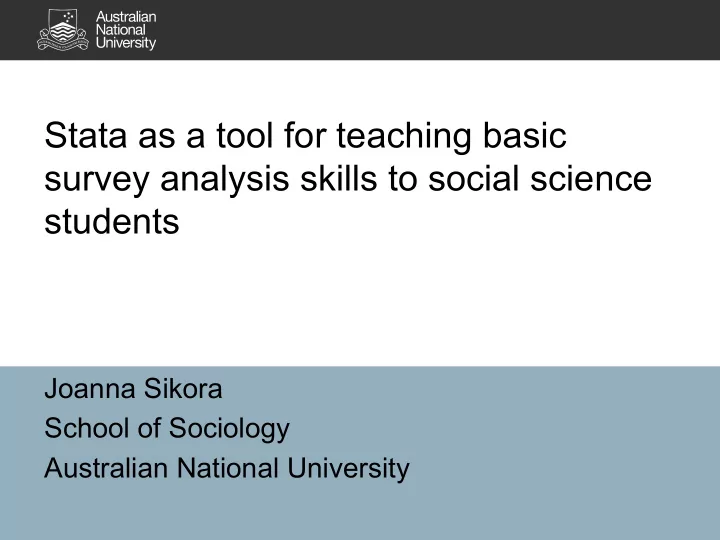

Stata as a tool for teaching basic survey analysis skills to social science students Joanna Sikora School of Sociology Australian National University
SOCY2038 Introduction to Quantitative Research Methods • No prerequisites – assumed Year 10 mathematics • Compulsory in BA Criminology • Sociology majors • Political science majors 2
Content Week 1 Week 2 Week 3 Week 4 Week 5 Week 6 Week 7 Week 8 Week 9 Week 10 Week 11 Week 12 Structure of quantitative analysis paper Designing the layout of crosstabulations, correlation matrices, OLS tables and writing about them Stata: basic preparation of data and analysis Descriptive statistics Crosstabs Correlations Bivariate and Multivariate OLS regression Survey design: theories, deductive reasoning, question and questionnaire design, types of samples Elementary statistical concepts Sampling Inference Crosstabs Correlations OLS regression Writing and reading skills Statistical software skills Conceptual skills Statistical knowledge 3
What (some) students say “Some of the content is very difficult for people who aren't mathematically minded. They can't grasp some concepts that quickly.” Did the lecturer stimulate your interest in the subject? “An impossible feat! :P “ “Numerous students who I have spoken to said this was the HARDEST course in the whole criminology degree … ” 4
How to get publication ready tables in few steps without user-written add-ons e.g. tabout; estab; estout? tab fam_ssexk gender, row +----------------+ | Key | |----------------| | frequency | | row percentage | +----------------+ A same-sex couple | Gender with children | 1. Female 2. Male | Total -------------------+----------------------+---------- 1. yes a family | 295 165 | 460 | 64.13 35.87 | 100.00 -------------------+----------------------+---------- 2. no not a family | 247 302 | 549 | 44.99 55.01 | 100.00 -------------------+----------------------+---------- Total | 542 467 | 1,009 Table 1. In your opinion is a same-sex couple with children is a family? Women Men Yes, a family 64% 36% No, not a family 45% 55% Total 54% 46% N 542 467% 5
How to get Stata to display 2 decimals in a correlation matrix? correlate fnbzpayq fnprospq fnstudyq fnpaywkq fnineqq fe100svq fe1savq feyrkidq (obs=1,111) | fnbzpayq fnprospq fnstudyq fnpaywkq fnineqq fe100svq fe1savq feyrkidq -------------+------------------------------------------------------------------------ fnbzpayq | 1.0000 fnprospq | 0.4906 1.0000 fnstudyq | 0.2721 0.2984 1.0000 fnpaywkq | 0.3581 0.3181 0.3662 1.0000 fnineqq | 0.3506 0.5089 0.2480 0.3319 1.0000 fe100svq | 0.0985 0.1258 0.0604 0.0614 0.0754 1.0000 fe1savq | 0.0898 0.1264 0.0466 0.0687 0.0862 0.8493 1.0000 feyrkidq | 0.0882 0.1206 0.0622 0.0651 0.1010 0.8435 0.7559 1.0000 6
How to get students from Stata output to this in as few steps as possible? Table 2. Correlation coefficients, means and standard deviations for attitudes to functionality of inequality, age, education and earnings in ISSSA 2001 1. 2. 3. 4. 5. 6. 7. 1.00 ** 1. Entrepreneurs should earn a lot 0.49 ** 1.00 ** 2. Income differences are necessary 0.37 ** 0.33 ** 1.00 ** 3. High salaries for prosperity 0.36 ** 0.51 ** 0.34 ** 1.00 ** 4. Inequality for economic progress 0.11 ** 0.08 ** 0.14 ** 0.15 ** 1.00 ** 5. Age in years 0.05 ** -0.05 ** -0.06 ** -0.02 ** -0.31 ** 1.00 ** 6. Education in years 0.10 ** 0.06 ** 0.02 ** 0.05 ** -0.24 ** 0.29 ** 1.00 ** 7. Annual earnings Mean 53.9 42.2 69.0 49.9 49.2 12.1 23,695 Standard deviation 24.6 23.5 20.2 23.9 15.4 2.9 31,744 Min 0 0 0 0 20 0 0 Max 100 100 100 100 89 18 288,395 N 53.9 42.2 69.0 49.9 49.2 12.1 23,695 Source: ISSSA 2001 **Coefficient significantly different from zero at p = 0.01 * Coefficient significantly different from zero at p = 0.05 7
How to get them from raw regression output to this? Table 2. Support for government ownership of industry & commerce in Australia in 1995. Ordinary Least Squares Regression Support for government-owned industry and commerce Unstandardized Standard Standardized coefficient error coefficient b SE Beta Age in years -0.11** 0.02 -0.08 Constant 55.96** 2.97 Adjusted R 2 0.10 (N of cases) 2368 Source: ISEA 1995 Note *Coefficient significantly different from zero at p = 0.05 **Coefficient significantly different from zero at p = 0.01 8
Recommend
More recommend